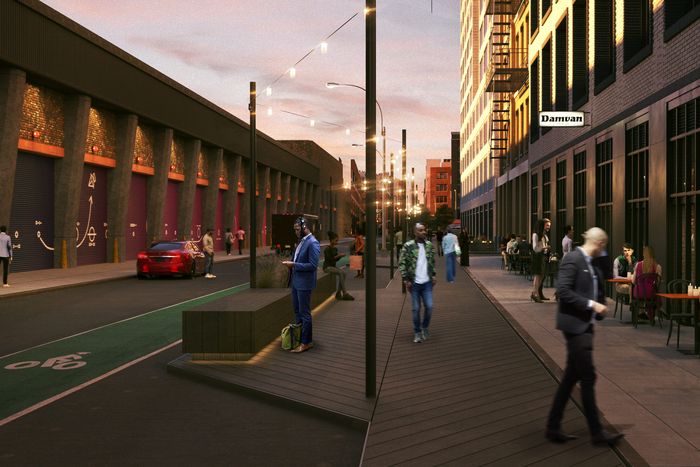
Last week, when Google announced it was buying the immense St. John’s Terminal for $2.1 billion — the most money spent on an office during the pandemic anywhere in the U.S. — many media outlets mistakenly reported the company was heading to Hudson Yards. It was an understandable error given that Facebook and Amazon already lease space in the Billionaires’ Playground. But no: Google is expanding its footprint in Hudson Square, down on the western fringe of Soho, where it already has two offices on Hudson Street. And as the search behemoth moves in, the local Business Improvement District is commissioning a plan to turn this area into something approximating an actual neighborhood. But because of Hudson Square’s inbuilt nature, that is going to be an uphill climb.
The area, which has a lot of former factory buildings with very large floor plates that once clacked with printing presses, is a relatively recent creation. It was just an unnamed slab of the west side, occasionally known as the Printing District, until one of its principal property owners, Trinity Real Estate, began a rebranding in the early 2000s. Its conversions gradually turned the neighborhood into a bit of a publishing hub, bringing in media companies that sought rents lower than they’d pay in midtown or the Financial District: Viking Penguin, ABC Radio, WNYC, Comedy Central — not to mention New York Magazine — all moved to Trinity buildings on Hudson or Varick Streets. Those tenants have more recently been joined (and in some cases replaced) by tech outfits like Warby Parker, Squarespace, Oscar health, and Harry’s razors. Before Google’s big office play, Disney made headlines in 2018 for the 1.2 million-square-foot campus it’s developing on the former site of City Winery. And that growing tech workforce is highlighting Hudson Square’s shortcomings as a neighborhood.
That’s because, for all its charms, Hudson Square is largely cut off from its surroundings by Holland Tunnel ramps and a four-block-long UPS building on Greenwich Street. It hardly functions at street level, mostly because it’s barely walkable. There are a few bars and restaurants, like the landmark Ear Inn and a Westville, but it’s a pretty thin selection until you pick your way east through the tunnel traffic into Soho proper. (At One Hudson Square, Trinity half-solved this problem by putting a restaurant inside the building, on the third floor, accessible only to tenants and their visitors.)
In an attempt to address all these issues before it’s flooded with even more tech workers, the Hudson Square BID released a $22 million plan this week that aims to make the area better for walking and biking. The BID’s proposal, done in partnership with architecture firm WXY, calls for a new sidewalk-level bike lane along Houston Street and a gleaming S-curve of a pedestrian bridge that runs from Spring Street over the West Side Highway. Both are aimed at providing better access to Hudson River Park, which despite technically being in Hudson Square is rather difficult to get to: There are fewer connections to cross to the park than in some of its neighbors, like Chelsea. The BID also proposes tying Hudson Square to Tribeca with a deck that would widen the sidewalk on Greenwich between Canal and Spring, taking some street space back from cars. And long-term, that block would be transformed into a curbless street.
In 2013, as part of the first phase of its plan to make the area more pedestrian- and bike-friendly, the BID built an odd little quasi park called Freeman Plaza West with a red painted concrete Noguchi sculpture right next to the Holland Tunnel’s entrance. At the time it was proposed, people were skeptical: “I’m not sitting there — that’s crazy,” Natasha Edwards, a worker in the area, told the New York Times in 2012. “It’s the mouth of the tunnel. Everyone’s running the light trying to get in there.” But it has turned out to be pretty popular among office workers during warm-weather lunch hours, especially since the beginning of the pandemic. It remains to be seen whether their future Googleplex neighbors — perhaps someday joined by their Facebook or Twitter equivalents, should this really become East Coast Tech Central, as Trinity clearly hopes — will have the spending clout to import some actual neighborhood charm.

